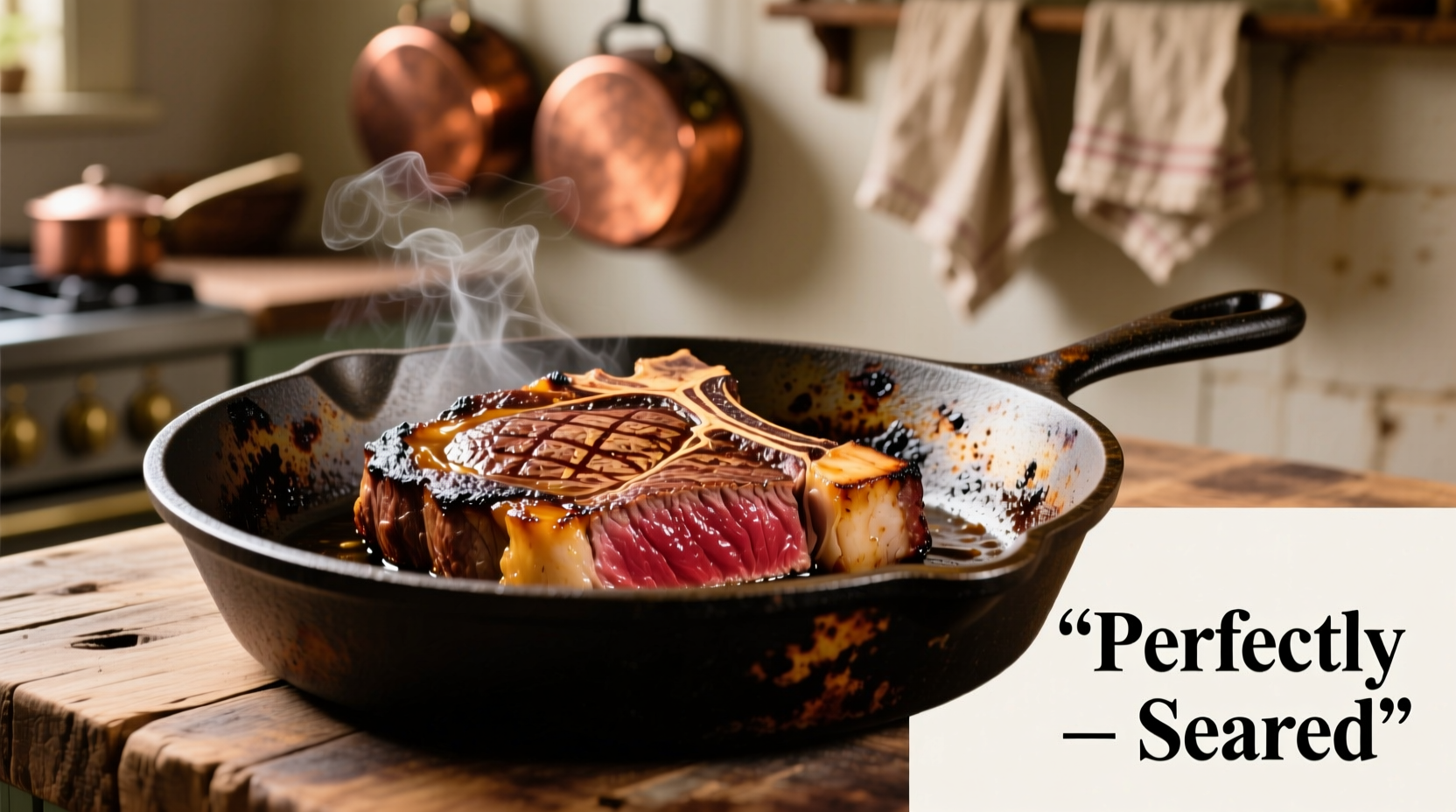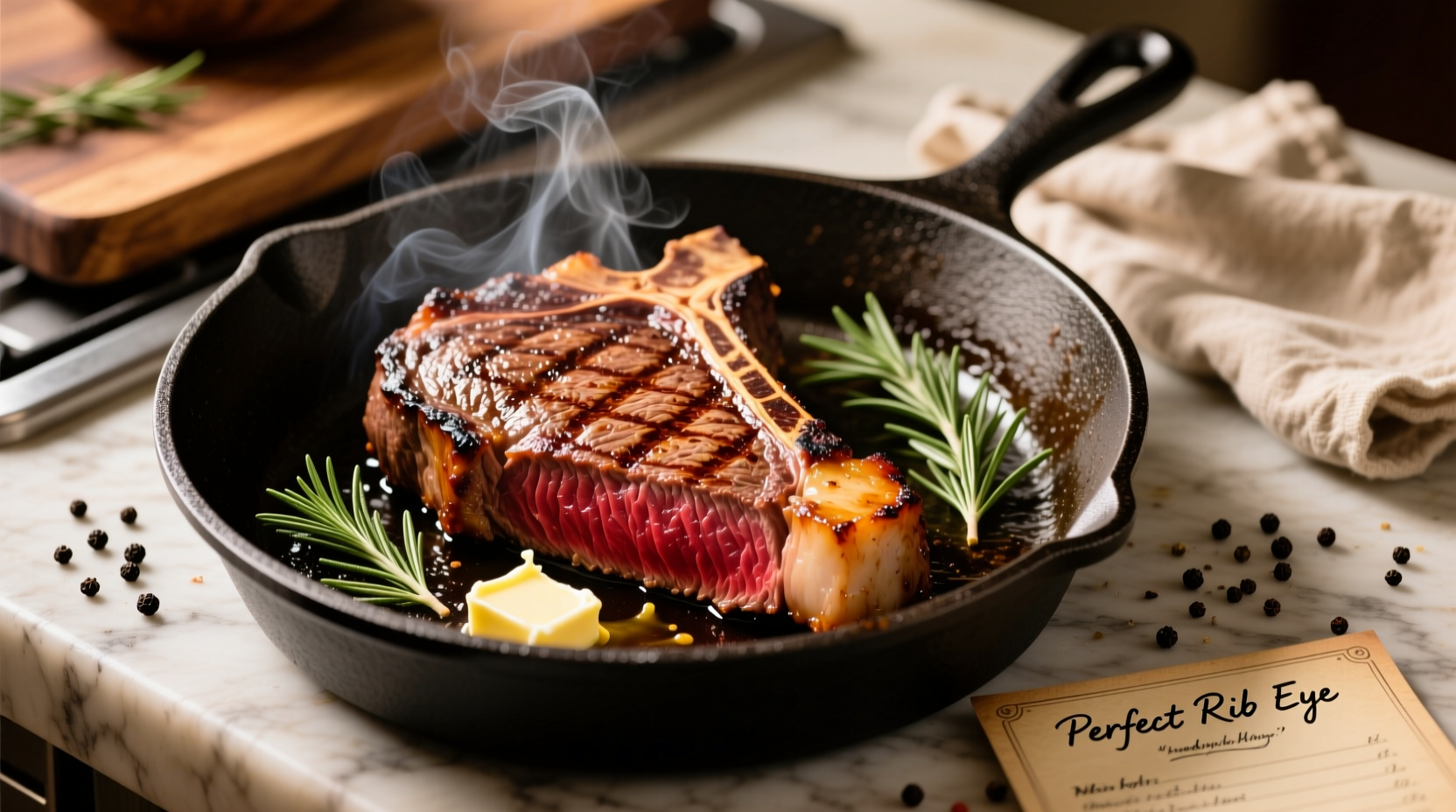Perfectly cook a rib eye steak in a cast iron skillet by bringing the steak to room temperature, seasoning generously, preheating your skillet to 500°F (260°C), searing for 3-4 minutes per side, finishing in a 400°F (204°C) oven if needed, and resting for 10 minutes. This method delivers a crisp crust and medium-rare center every time.
- ✓ Achieve restaurant-quality results at home
- ✓ Create the perfect Maillard reaction crust
- ✓ Master internal temperature control
- ✓ Avoid common steak-cooking mistakes
The Cast Iron Advantage for Rib Eye Steaks
When cooking a premium cut like rib eye, your cooking surface matters significantly. Cast iron outperforms other materials for steak preparation due to its exceptional heat retention and distribution properties. Unlike stainless steel or non-stick pans that cool dramatically when cold meat hits the surface, cast iron maintains consistent high temperatures essential for proper searing.
| Cooking Surface | Heat Retention | Max Temperature | Searing Quality | Best For |
|---|---|---|---|---|
| Cast Iron | Excellent | 500°F+ (260°C+) | Superior crust formation | Steaks 1.5" thick or less |
| Stainless Steel | Good | 450°F (232°C) | Good | Thicker cuts requiring oven finish |
| Non-Stick | Poor | 400°F (204°C) | Poor | Not recommended for steak |
| Carbon Steel | Very Good | 500°F (260°C) | Excellent | Alternative to cast iron |
According to the American Meat Science Association's Meat Cooking Guidelines, achieving surface temperatures above 300°F (149°C) is critical for the Maillard reaction that creates complex flavor compounds and that desirable brown crust. Cast iron reliably reaches and maintains these temperatures where other materials falter.
Preparation: Setting Up for Success
Proper preparation separates good steaks from exceptional ones. Begin with a 12-16 ounce rib eye steak, preferably 1.5 inches thick. Thinner cuts risk overcooking before proper searing occurs. The USDA Food Safety and Inspection Service recommends cooking steaks to a minimum internal temperature of 145°F (63°C) with a 3-minute rest for medium doneness, though many prefer medium-rare at 130-135°F (54-57°C).
Remove your steak from refrigeration 60-90 minutes before cooking. This critical step allows the meat to come to room temperature throughout, preventing the common mistake of a cold center with overcooked exterior. Pat the steak thoroughly dry with paper towels—moisture is the enemy of proper searing.
Season generously with coarse kosher salt and freshly ground black pepper. For optimal flavor development, season at least 45 minutes before cooking to allow the salt to penetrate the meat surface. Some chefs recommend adding salt up to 24 hours in advance for even better results, as documented in Harold McGee's On Food and Cooking: The Science and Lore of the Kitchen.
The Cooking Process: Step-by-Step
Place your cast iron skillet on the stove over medium-high heat for 5-7 minutes until properly preheated. Test the temperature by sprinkling a few drops of water on the surface—they should sizzle and evaporate immediately. For precise temperature control, aim for 500°F (260°C) as measured by an infrared thermometer.
Once your skillet is properly heated, carefully place the steak in the pan, laying it away from you to avoid oil splatter. You should hear an immediate, vigorous sizzle. Cook undisturbed for 3-4 minutes to develop a proper crust. Resist the urge to move or press down on the steak—this disrupts crust formation.
After the initial sear, flip the steak using tongs and cook for another 3-4 minutes. For thicker cuts (over 1.5 inches), add 1-2 tablespoons of high-smoke-point oil (like avocado or grapeseed) to the pan along with aromatics such as crushed garlic cloves, fresh thyme, or rosemary sprigs. Tilt the pan and spoon the hot oil continuously over the top of the steak for enhanced flavor and even cooking—a technique known as butter basting.

Monitor internal temperature using an instant-read thermometer. For medium-rare, remove the steak when it reaches 120-125°F (49-52°C), as carryover cooking will raise the temperature during resting. The National Cattlemen's Beef Association confirms that rib eye steaks continue cooking 5-10°F (3-6°C) after removal from heat.
The Essential Resting Phase
Resting isn't optional—it's a critical step that determines your steak's final texture and juiciness. When you remove the steak from heat, transfer it to a cutting board or warm plate and tent loosely with foil. Rest for 8-10 minutes for a standard 12-16 ounce steak.
During this time, the muscle fibers relax and reabsorb juices that would otherwise pour out when sliced. Cutting too soon results in significant moisture loss—up to 40% according to research published in the Journal of Food Science. The ideal resting time follows this timeline:
- 0-2 minutes: Surface temperature drops rapidly from 140°F to 125°F (60°C to 52°C)
- 3-5 minutes: Internal temperature rises 5-10°F (3-6°C) due to carryover cooking
- 6-8 minutes: Muscle fibers begin to relax and reabsorb juices
- 8-10 minutes: Optimal balance of temperature and juice retention for slicing
Troubleshooting Common Issues
Problem: Steak sticks to the pan
Solution: The pan wasn't hot enough before adding the steak. Properly preheat cast iron until water droplets dance across the surface.
Problem: Uneven browning
Solution: Inconsistent heat distribution. Rotate the steak 90 degrees halfway through each side for even grill marks and cooking.
Problem: Burnt exterior but raw interior
Solution: Pan was too hot or steak was too cold. Bring steak closer to room temperature and consider finishing thicker cuts in a 400°F (204°C) oven after initial sear.
Problem: Excessive smoke
Solution: Turn on your exhaust fan, open windows, and consider using an oil with higher smoke point like avocado oil (smoke point 520°F/271°C) instead of olive oil.
Perfect Pairings for Your Rib Eye
A perfectly cooked rib eye needs minimal accompaniments to shine. Consider these classic pairings that complement without overwhelming the rich beef flavor:
- Simple garlic butter compound spread
- Roasted asparagus with lemon zest
- Crispy smashed potatoes
- Full-bodied red wine like Cabernet Sauvignon
When slicing, cut against the grain with a sharp knife for maximum tenderness. Rib eye has a distinctive marbling pattern that creates different grain directions in various sections—adjust your slicing angle accordingly for the most tender bite.











 浙公网安备
33010002000092号
浙公网安备
33010002000092号 浙B2-20120091-4
浙B2-20120091-4